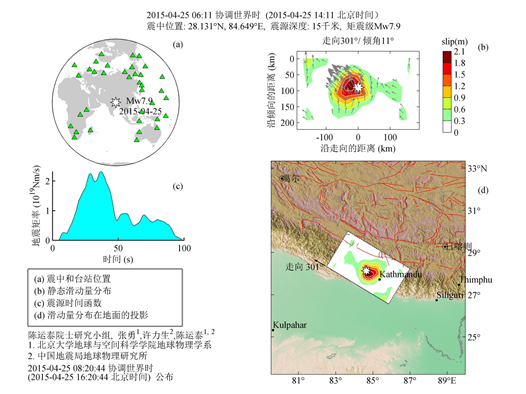SESS fast estimated the rupture model and major characteristic of the 2015 Nepal earthquake An Ms8.1 earthquake struck Nepal near Tibet, at 14:11 on 25 April 2015. Up to 26 April, the earthquake has caused more than 2000 deaths, including at least 17 Chinese. Two hours and nine minutes after the earthquake occurrence, Dr. Yong Zhang, a member of Yun-Tai Chen's group in School of Earth and Space Sciences (SESS), successfully determined the rupture model of this earthquake, and estimated the major disaster characteristics.
SESS fast estimated the rupture model and major characteristic of the 2015 Nepal earthquake
An Ms8.1 earthquake struck Nepal near Tibet, at 14:11 on 25 April 2015. Up to 26 April, the earthquake has caused more than 2000 deaths, including at least 17 Chinese. Two hours and nine minutes after the earthquake occurrence, Dr. Yong Zhang, a member of Yun-Tai Chen's group in School of Earth and Space Sciences (SESS), successfully determined the rupture model of this earthquake, and estimated the major disaster characteristics.
Zhang's model shows that the earthquake magnitude is about Mw7.9. The rupture mainly propagated to the southeast, which may cause more terrible damages around Kathmandu. Meanwhile, since the rupture did not reach the ground surface, the intensities of this Nepal earthquake would be weaker than those of the 2008 Wenchuan earthquake, although the scales of the two earthquakes are almost identical.
Rupture process is the most important source parameter for estimates of earthquake disasters. Ruptures of large earthquakes do not simply occur at the hypocenter (a point), but propagates from the hypocenter to certain direction on a 2-D plane, and finally forms a fault with dimension of several hundreds to more than one thousand kilometers. For example, during the 2008 Wenchuan earthquake, ruptures initiated near Yingxiu, and propagated to the northeast and caused a 300 km long fault, resulting in several meizoseismal areas such as Yingxiu, Beichuan and Qingchuan. To effectively conduct earthquake relief and allocate rescue forces, it is necessary to determine these meizoseismal areas. The purpose of rupture process inversion is to provide the locations of these areas by fast inverting seismic recordings.
Because of the complexity of earthquake physics, however, inverting seismic data for rupture processes is a highly instable problem in seismology. It is a challenge work to simultaneously reduce the inversion time and ensure the reliability. For fast emergency responses, each saved second would be valuable. Since 2003, Yong Zhang and Yun-Tai Chen have conducted a series of researches on inversions of rupture process. After the 2008 Wenchuan earthquake, they began to implement a routine work of fast source inversion for significant earthquakes, and successfully reduced the inversion time from 5 hours to about 2 hours. Their works have played important roles in emergency responses of the 2010 Yushu and 2013 Lushan earthquakes.

The Miniposter of the fast model of rupture process

Animation of the rupture process of the 2015 Nepal earthquake